The exact date when the second series was issued is not featured in the catalogues. All they state is 1945/1946. The second series is philatelically more interesting as there are some rare perforation varieties, some of which have not even be catalogued yet. Take for example the 3c value of the set below. It is catalogued by Michel with three perforation varieties (14:14, 11.5-12:14 and 11.5:11.5) however this stamp is perforated 12:12 so is as of yet unlisted. There are also different kind of colors on the original stamps (please see the 30c and 40c values below), Finally, on the 15c value there are two different kind of colors for the overprint (again, see below). One in the standard black and one in dark green. 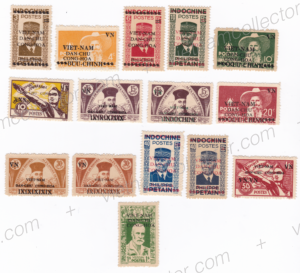
Here is the 30C cancelled to order with the rare perforation variety 12.
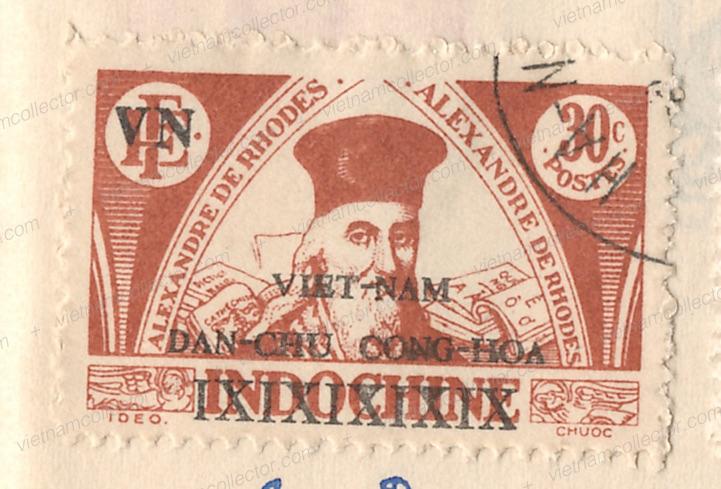
There are a number of known errors on the series that either stem from errors on the original stamps or errors in overprint.
Mint block of four of the 3C value on which the two top stamps show overprint errors. The left stamp shows a partially missing “M” in “NAM” and a partially missing horizontal top line obstructing “EF”. The right stamp shows a partially missing “VIET-NAM” overprint.
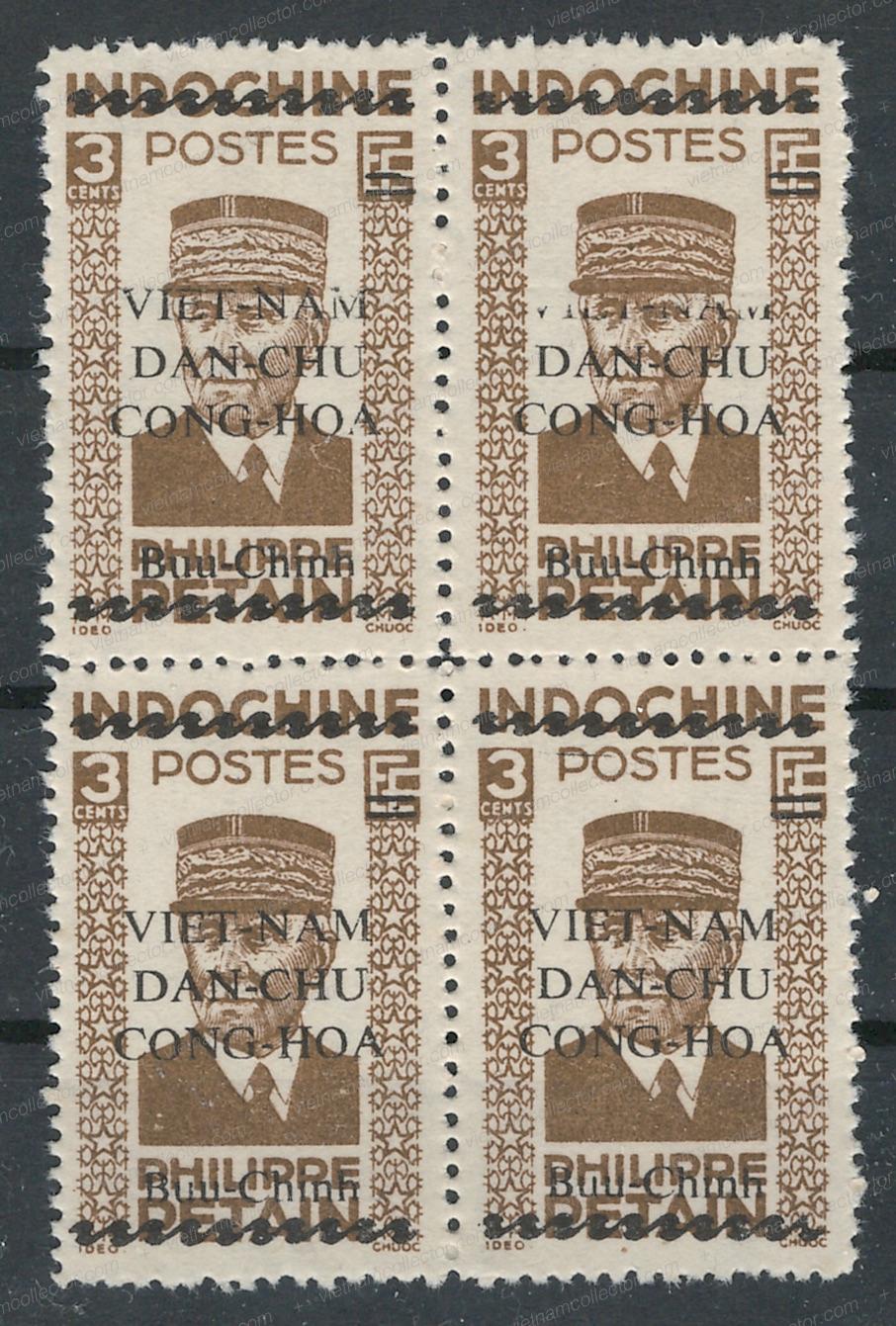
Below is the 3c value with a partially missing overprint (the country name “Vietnam” is only visible in a fragment/Field B9):
here is the same error but this time on a cancelled to order stamp of which the editor has a complete sheet.
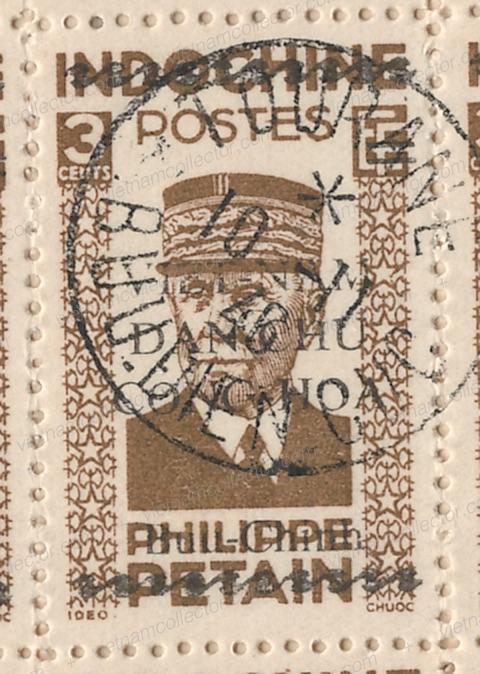
Rare perforation variety of the 3C overprinted stamp showing a perforation of 12:14 in this mint pair.
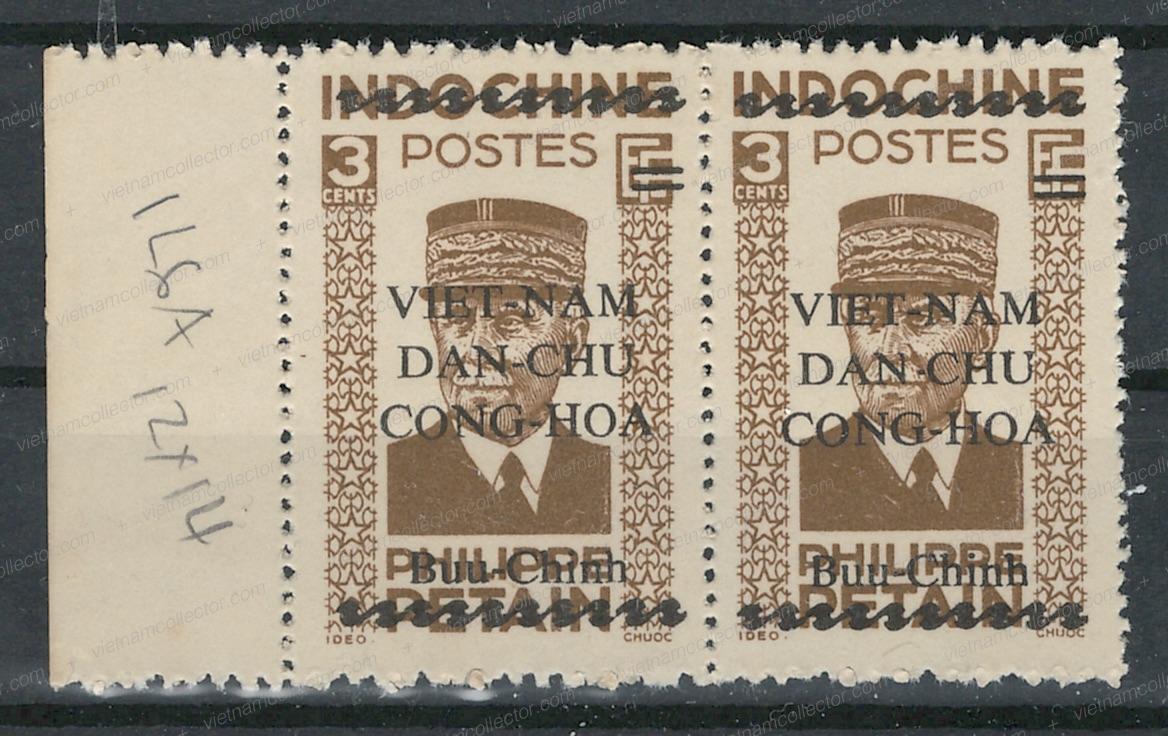
Here are two 3C stamps in the rare 12:14 perforation cancelled to order. The right stamp shows a very weak overprint.
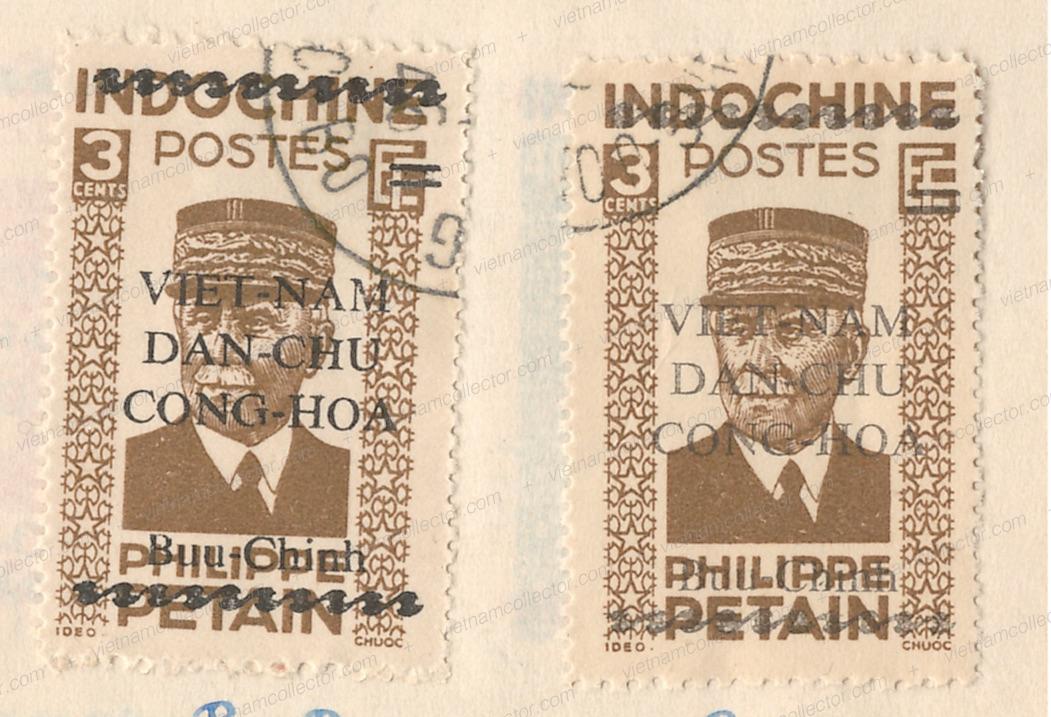
The 3C overprinted stamp is known printed on white paper and tanned paper. Here are both versions.

The 4c value is also known with the so called “missing C” variety (middle stamp in the lower row). The partially missing “C” is the result of shoddy reproduction work during the cliche reproduction process. All white areas should have been covered during the color printing phase but apparently the cover that represented the “C” was only partially applied resulting in the area where the “C” should have been filled with color. This is obviously an error on the original stamp that was then carried on to the overprints.
On field B5 one can find the error of “right vertical line of N in VN broken”.
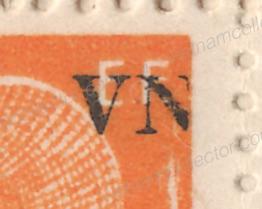
On field C1 one can find the error “black dot between H and I of CHINH”.
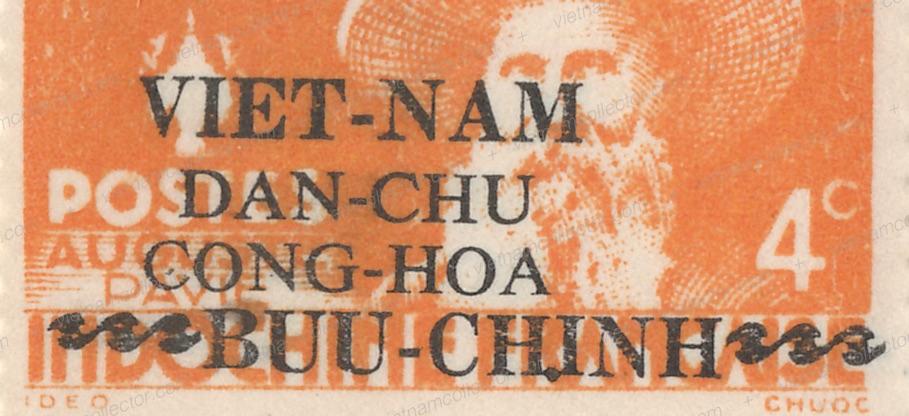
On fields J2, J3, J4 and J5 one can find the error “B of BUU open at bottom and bottom of H in first H of CHINH partially missing.

There are a number of overprint errors on the 6C value. Here is a stamp on which the “OA” of “HOA” are partially broken an error that can be found on Field E1.
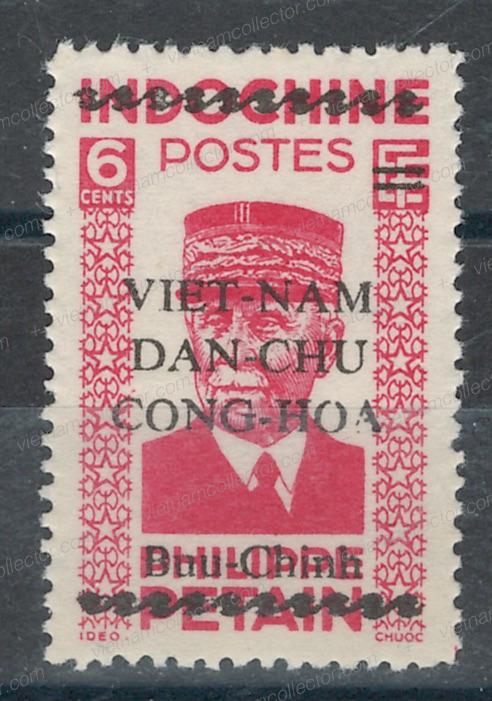
Detailed scan of the affected area.

On Field B5 one can find the error “I in VIET-NAM slanted”.
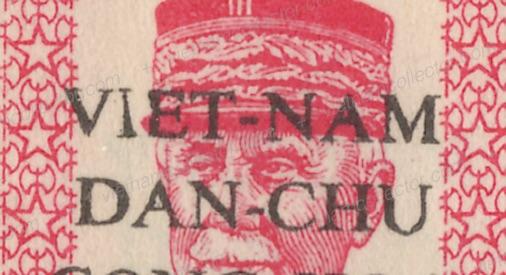
On field B2 one can find the error “black dot inside D and broken O in CONG”.
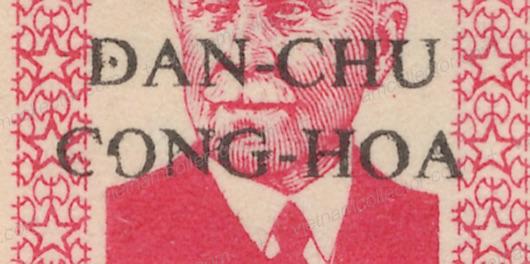
This stamp shows an broken “N” in NAM” and an “E”” in “VIET” that is partially closed.
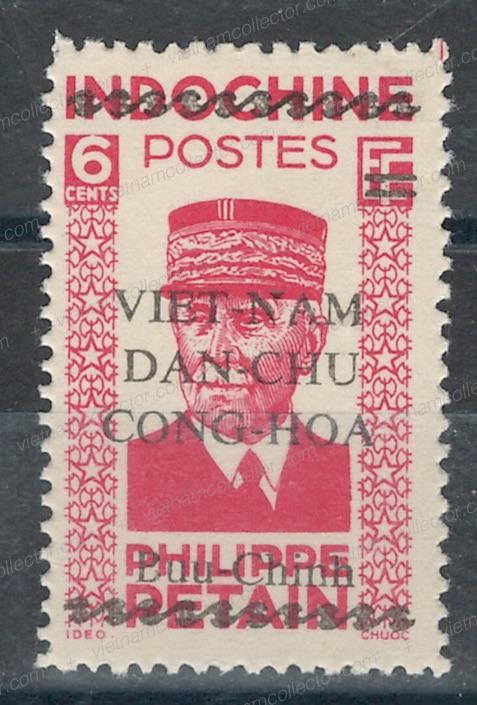
Detailed scan of the affected area.
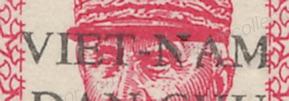
6 C stamp with an overprint error that shows a broken “C” in CHU”
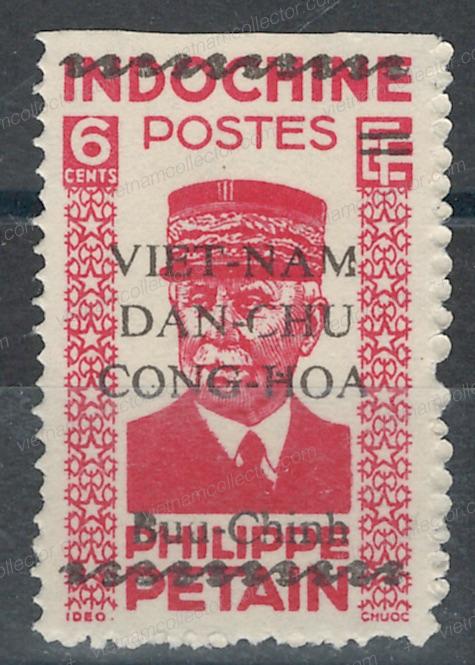
Detailed scan of the affected area.
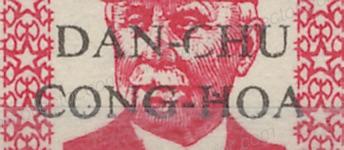
Here is a 6C stamp that shows an overprint error of “black dot in O of HOA”.
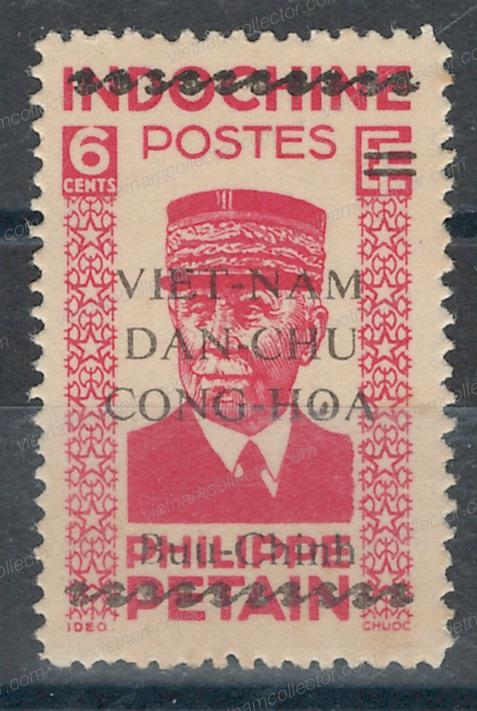
Detailed scan of the affected area.

Another 6C stamp with two overprint errors. One is the broken A and M in “NAM” and O of “CONG open at bottom.

Cancelled to order 6C stamp with overprint error “broken V and M in VIETNAM”.
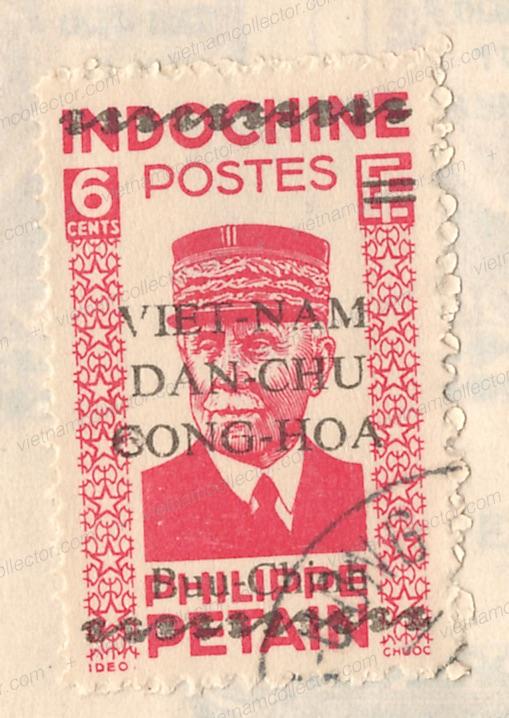
Detailed scan of the affected area.

Block of four of the 6C stamp on which the top left stamp shows a “broken T in VIET”.

Detailed scan of the affected area.

On field C6 one can find the error “black dot inside O of CONG”.
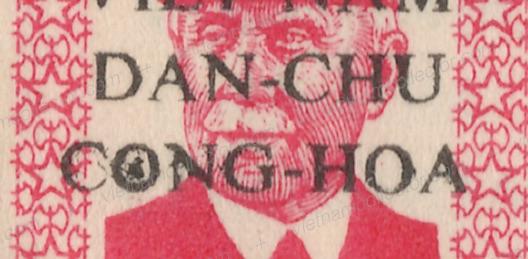
On field C8 one can find the error “broken D in DAN”.
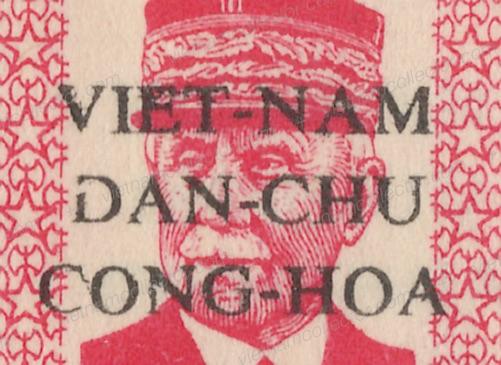
On field C10 one can find the error “C in CONG smeared and broken N in CONG”.
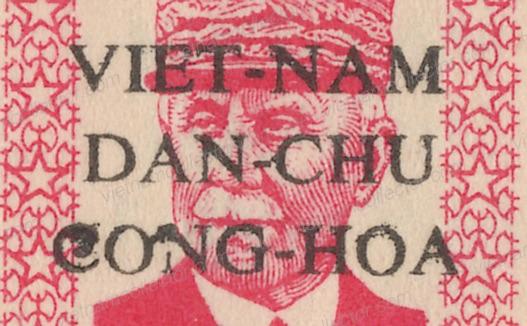
Here is a 10C stamp with the overprint error of “broken G” in “CONG”.

Detailed scan of the affected area.

Block of four of the 10C on which the top right stamp shows a broken “C” in CONG” and the bottom right stamp “a dot instead of a hyphen in CONG-HOA”.

Detailed scans of the affected area.


on field A10 one can find the error “M in VIET.NAM broken on top:
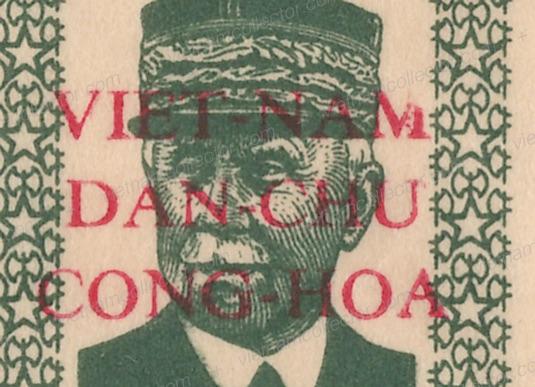
On fields B5 and E5 one can find the error “right vertical line in N of VN broken.
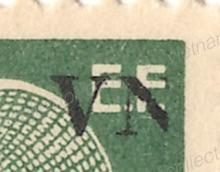
on fields J2 and J4 one can find the error “bottom of B in BUU open and First H in CHINH short at bottom”.

Cancelled to order 15C stamp with the black overprint on which the right base stamp shows the plate error “white spot in hat of Rhodes”.
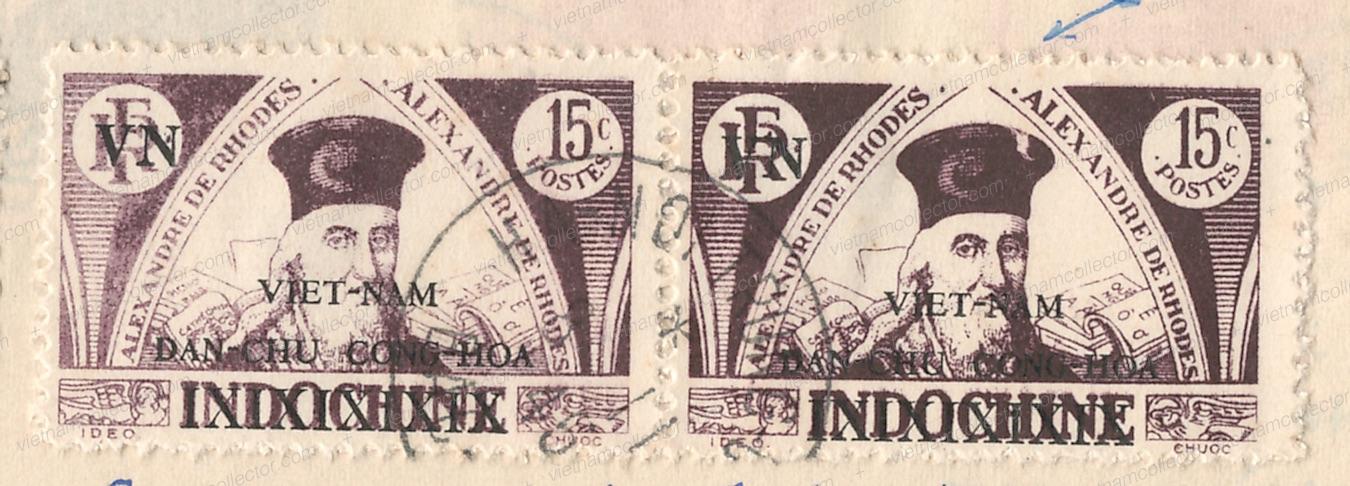
Detailed scan of the affected area.
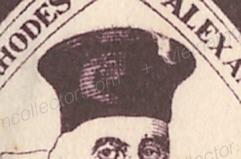
There are a number of overprint plate errors on the 15C stamp. On Field B2 one can find the overprint error “O of HOA completely filled”. These only appear on a partial printing.
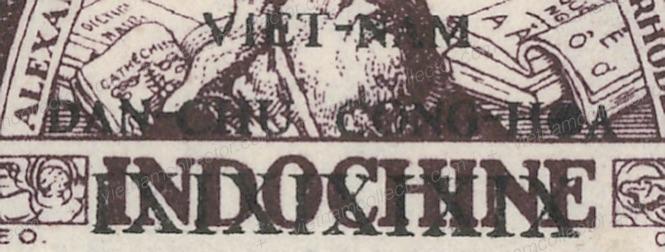
on Field C3 one can find the error “H of HOA filled completely”.
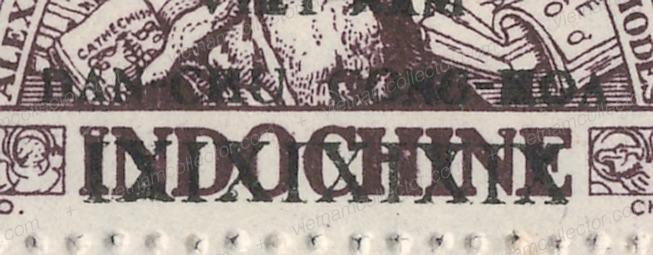
and on FieldF3 the error “O in HOA broken”.
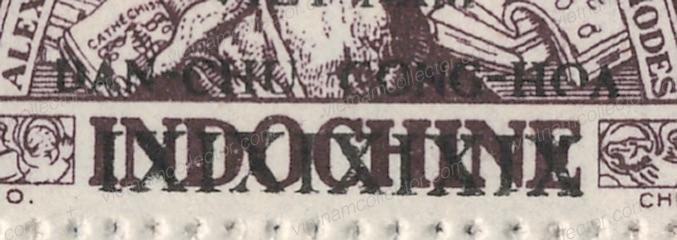
The same error also appears on the 20c value as both, the 4cent and 20c value were printed off the same plate (other than the nominal of course). See the bottom right stamp:
On fields A1 and G1 one can find the error “V and N of VN connected at top”.
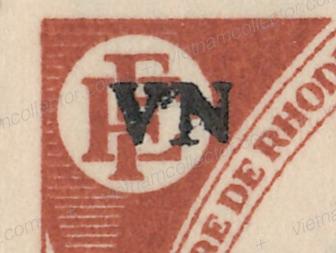
On field A4 one can find the error “E OF VIET_NAM solid and H of HOA solid at bottom.
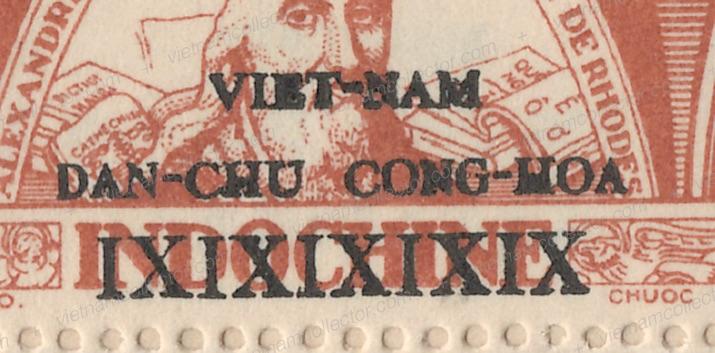
On field C2 one can find the error “E of VIET-NAM said at bottom, G of CONG looks like an O and O of HOA solid”.
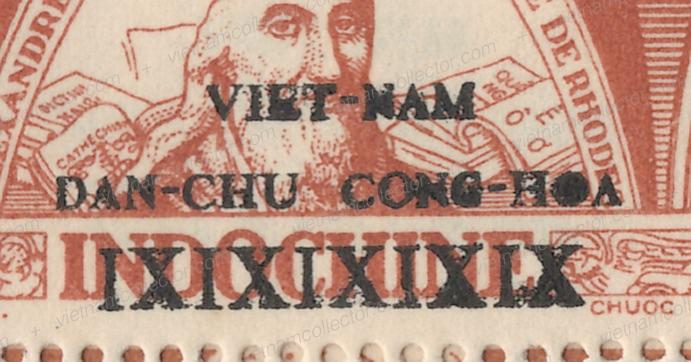
On field F3 one can find the error H of HOA solid and O of HOA broken”.
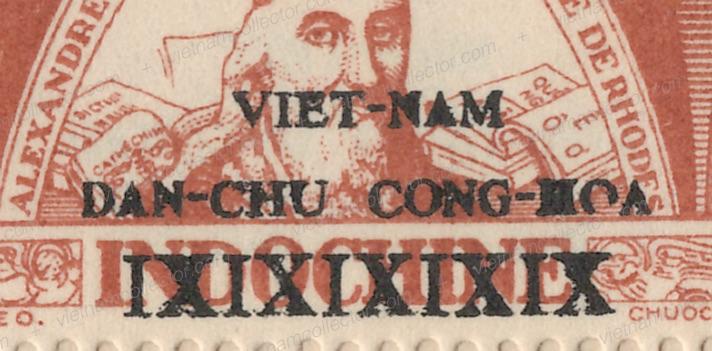
On field J1 one can find the error “G of CONG looks like an O and A of HOA short”. All stamps at the bottom of each sheet (J1 through J10) also show the error “Roman numerals at bottom short”.
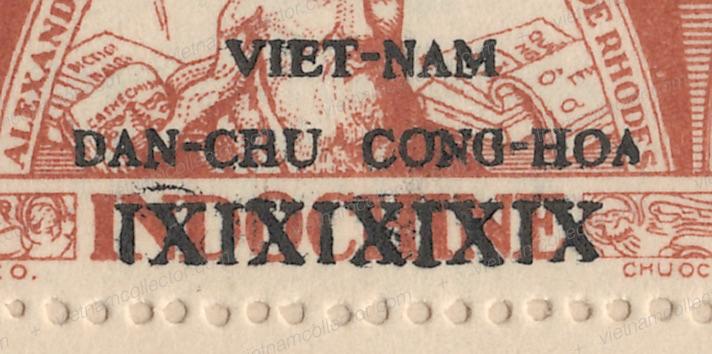
On field E4 one can find the error “E of VIET-NAM solid at top at H of HOA solid”.
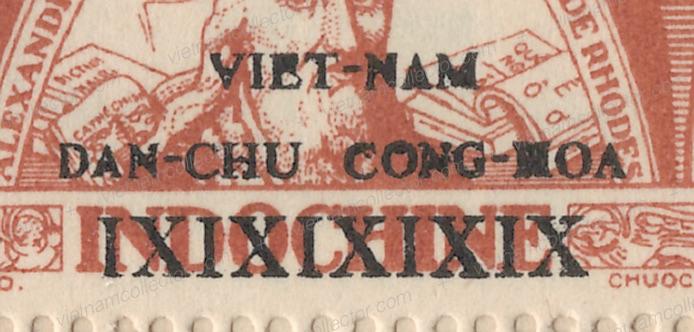
The 30c value in orange-brown is also known with a double overprint:
Here a rare multiple in a mint bloc of four in the very rare Perforation 11.75 (unlisted in catalogue):
and an overprint that is upside down:
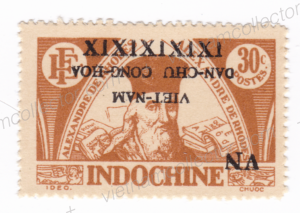
Mint 40C stamp on which the base stamp shows the plate error of “broken 4 in 40”.

Detailed scan of the affected area.

Cancelled to order 40C stamp with a rather smeared overprint showing the overprint error “closed C in CONG”.

Detailed scan of the affected area.
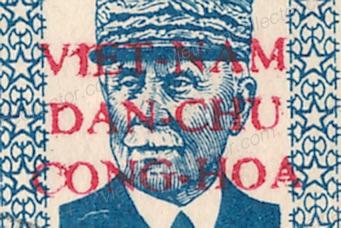
there are additional overprint-error. On field A 10 one can find the error M in VIET-NAM damaged on top”.
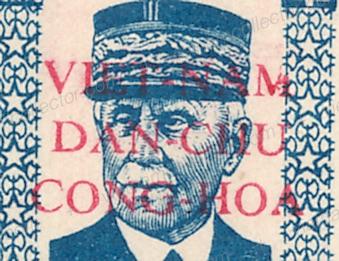
on field B7 one can find the error A in HOA damaged”.
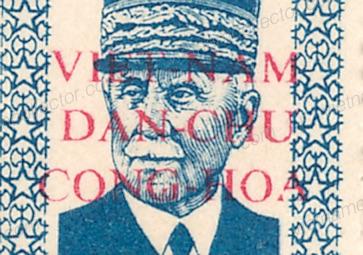
There are a number of overprint plate errors on this stamp. One can find the error “broken U in CHU! on Field B2.
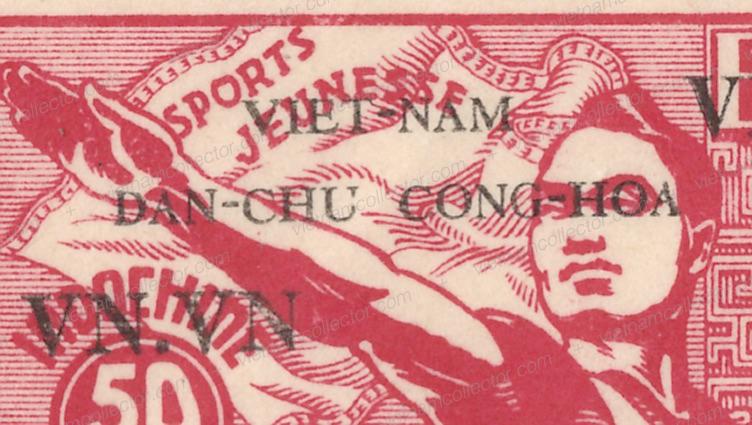
On field C1 the error “broken N in NAM”.
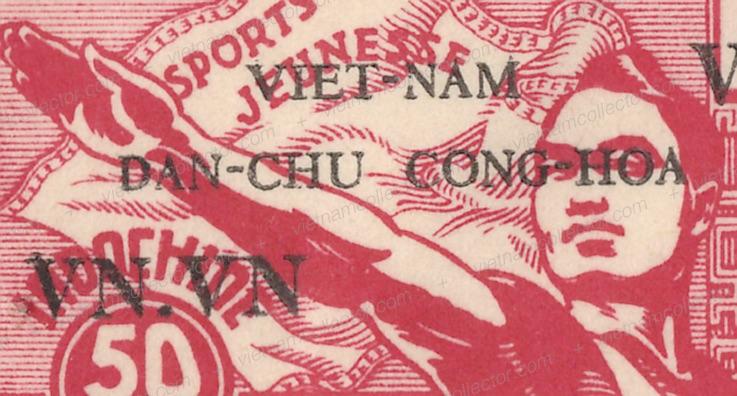
on field D5 the error “broken slanted on in N of CONG”.

on fieldsE4 and H4 the error “broken O in CONG”.
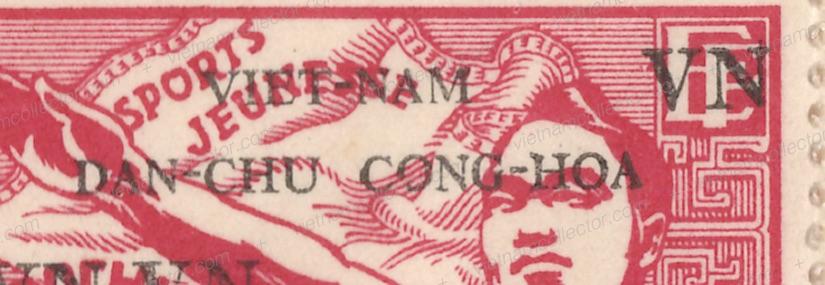

on field I5 the error “diagonal of N broken in CONG”.

on field I3 the error “broken V in VIET-NAM”.

on field I1 the error “broken right vertical line of H in CHU”.
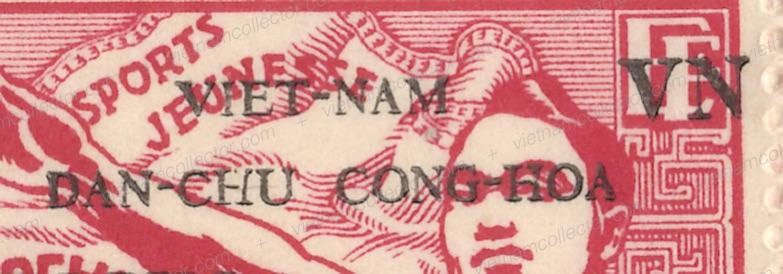
there are some overprint-errors on the 1P value. On field A1 one can find the error “I and E in VIET connected and C in CONG solid”.
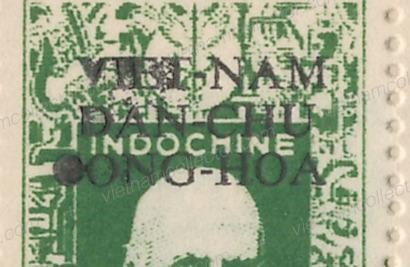
on field C4 one can find the error of D in DAN broken”.
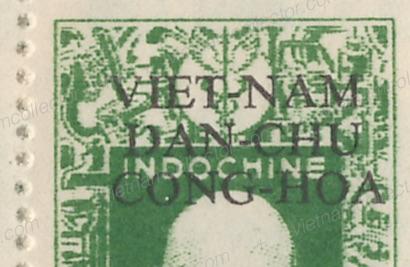
Extremely rare imperforate 15C stamp with the green overprint from the top margin. So far the editor has only seen a handful of imperforate overprinted stamps which suggests that only one imperforate sheet received the overprint.
As described under the first series of the overprints postally used letters are very rare. Below is a local letter with an interesting mixed franking of the dark-green and black overprints on the 15c value. It is correctly franked with 30c but probably has a philatelic origin. Nevertheless, a very rare mixed franking, that the editor has not seen anywhere else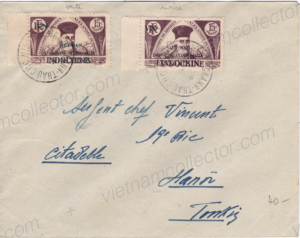
This is another local letter franked correctly at 30 cents with a pair of the 15c Rhodes value with green overprint. This letter did travel through the mail as signified by the Hanoi Bak Bo arrival cancel on the reverse.
Local letter (center fold not affecting stamps) franked correctly at 30 cents with a pair of the 15c Rhodes value with green overprint. Sent from Haai Phong in April of 1946 to Saigon.
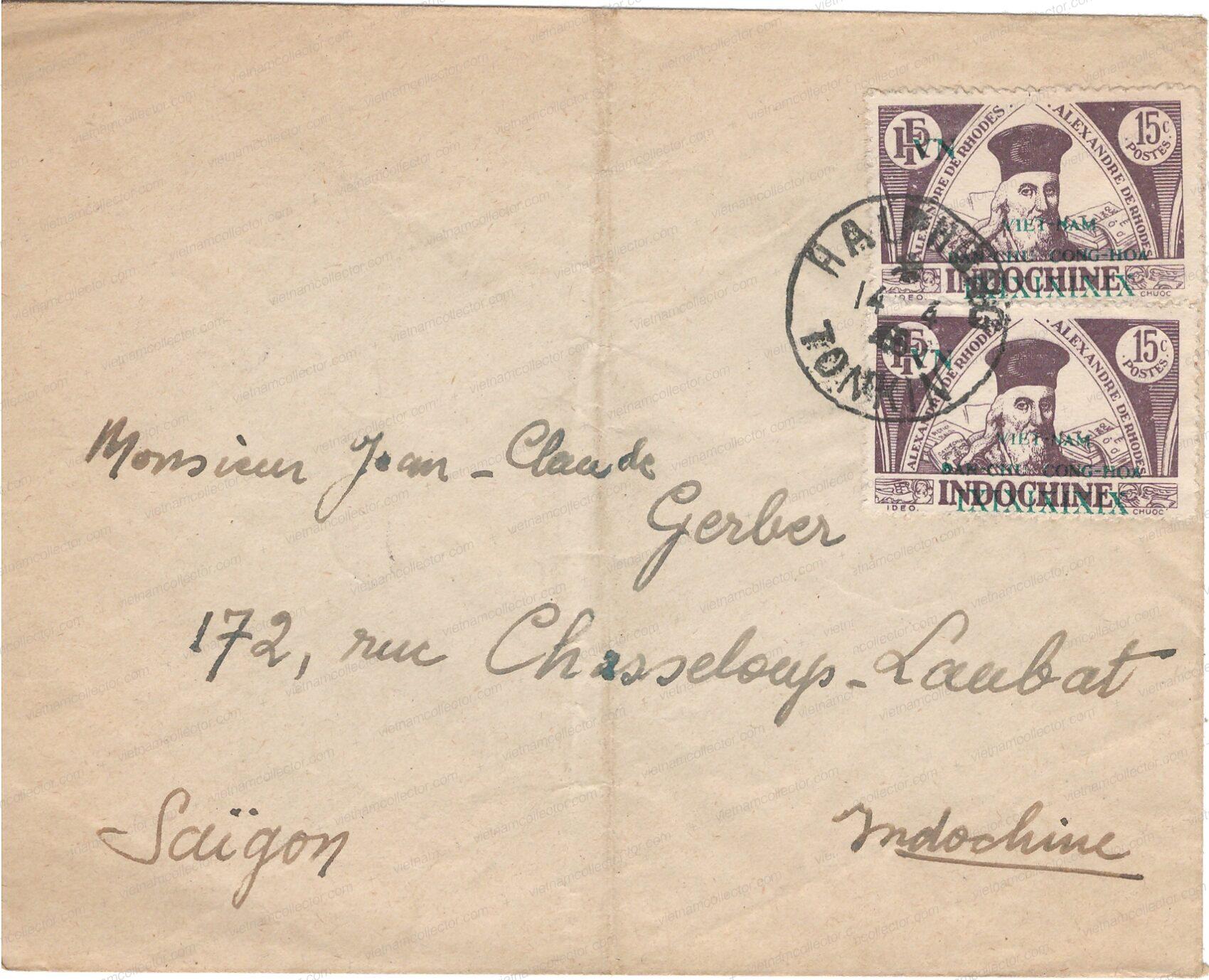
Interesting multiple franking of the black overprinted Rhodes stamp paying the standard letter rate of 30C on a domestic North-South letter sent from Hanoi to Dalat in July of 1946.
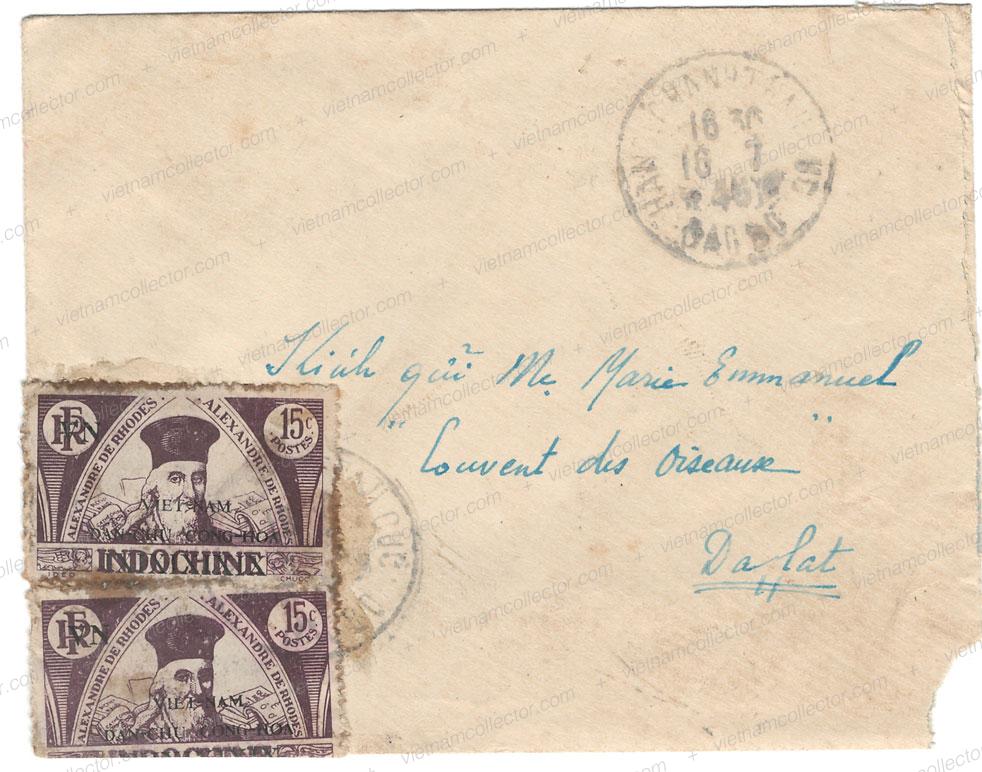
Adversity cover from Haiphong to Ninh Binh franked with a pair of the 15c Rhodes issue with black overprint. Transit cancels “Hanoi” on reverse. Correctly franked with 30c.
Domestic letter that was probably philatelically inspired. It carries both overprint colors of the 15C Rhodes value (green and black) as well the orange brown 30C Rhodes value in the rare perforation 12 (stamp on top) and the yet un-catalogued 30C Rohode stamp in yellow-brown in perforation 13.5:12.5 (stamp at the bottom).The letter traveled through the mail as indicated by the arrival cancel on the reverse of the cover but it is well over franked. 90 C was the postage for registered letters while 30C was sufficient for standard letters.
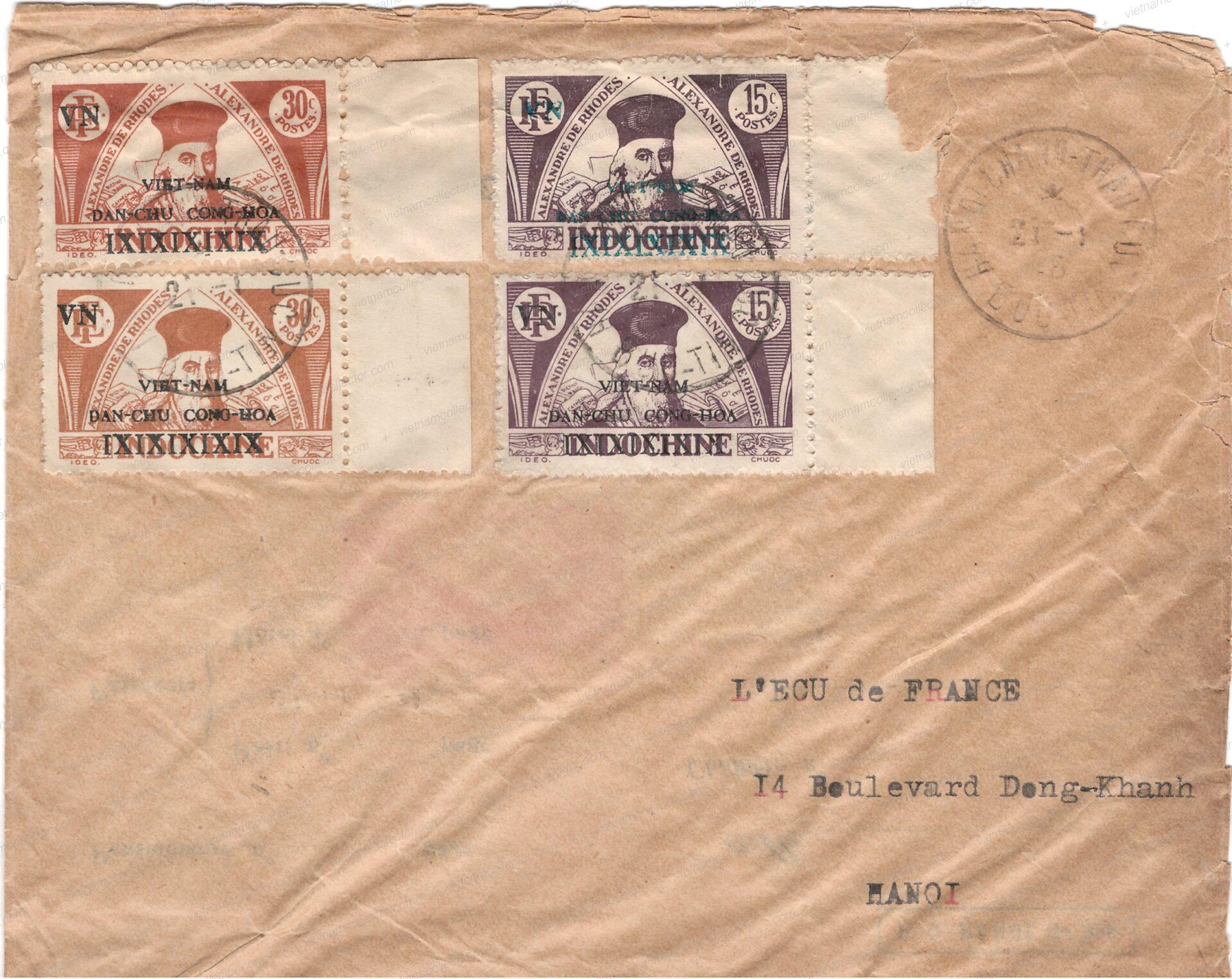
Here is a registered letter sent by the Asia Life Insurance Company to a client bearing the correct 90c franking (30c for the standard letter and 60c for the registration surcharge) on the reverse (made up of six 15c values with black overprint). The letter could not be delivered and so it was returned to the sender (see the black hand stamp “Return to sender” and manuscript remark).
A very similar registered cover sent on July 31st, 1946 within Hanoi also correctly franked with 90 cents (30 cents standard letter rate plus 60 cents for registration) made up of 6 of the 15c Rhodes value this time with the green overprint.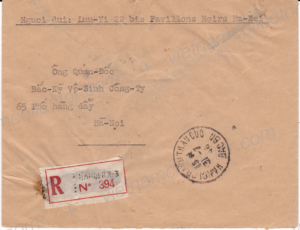
Registered letter mailed within Hanoi in February of 1946 featuring a blok of four of the 20C value plus a pair of the 5C value for an overall postage of 90C. 90 cents was the correct postage for a registered 20g letter at the time.
Rare multiple franking of the 20c value on a registered letter sent inside Hanoi in February of 1946. The letter is over- franked by 10c as the standard postage for a registered letter amounted to only 90c for a 20g letter.
Rare combination of the 40c Douart de Lagree and 50c “Sport” stamp on a registered letter sent by the Asia Life Insurance Company. An attempted delivery of the letter was made on March 13th, 1946 and because it could not be delivered it was returned on April 15th, 1946 (as documented by two manuscript comments on the back). The front carries two hand stamps that state: “Phat Lan Chat” which means “Delivery Impossible” and “Gia Lai Nguoi Gui which stands for “Return to sender”. A French hand stamp which states “return to sender” was also added.
Registered letter mailed inside of Hanoi featuring a block of four of the 50C value over-paying the required registered letter tariff of 90C. So, either this letter was quite a bit heavier than the standard 20g or was of philatelic origin.
Here is another registered letter sent by the Compagnie Franco American A’Assurance on January 26, 1946. It has an arrival cancel on the back date January 28, 1946. It is oversized and was much heavier than the standard letter rate allowed (original contents preserved). It carries a block of four each of the 15c value (black overprint), the 30c value with the rare 12:12 perforation as well as a pair of the $1 (1 Piastre) value for a total postage of $3.80. The latter is extremely rare on cover and would only have been used for such large/heavy letters or on packages. As a result most of them were discarded or did not survive the tropical climate.
You are more likely to find these stamps on philatelic products such as the one below that was produced by the “House of Then Wen”. It usually features a pair of the black-overprinted version of the 15c Rhodes value with a special cancel commemorating the 1st National Assembly on March 3, 1946. The envelopes were sold for $3 (3 Piastres) a hefty surcharge on the nominal of 30 cents. They also carry a cachet that states “Assembly of the People/Representatives of all the Nation in the Solemn Party/Opening of the First Reunion/Democratic Republic of Vietnam”.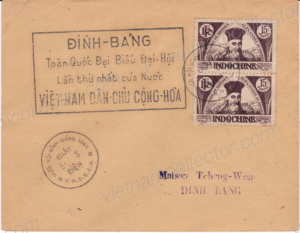
More rare is the version that carries the 15c value and 30 cent yellow-brown value Rhodes:
The cachet also exist in red color.
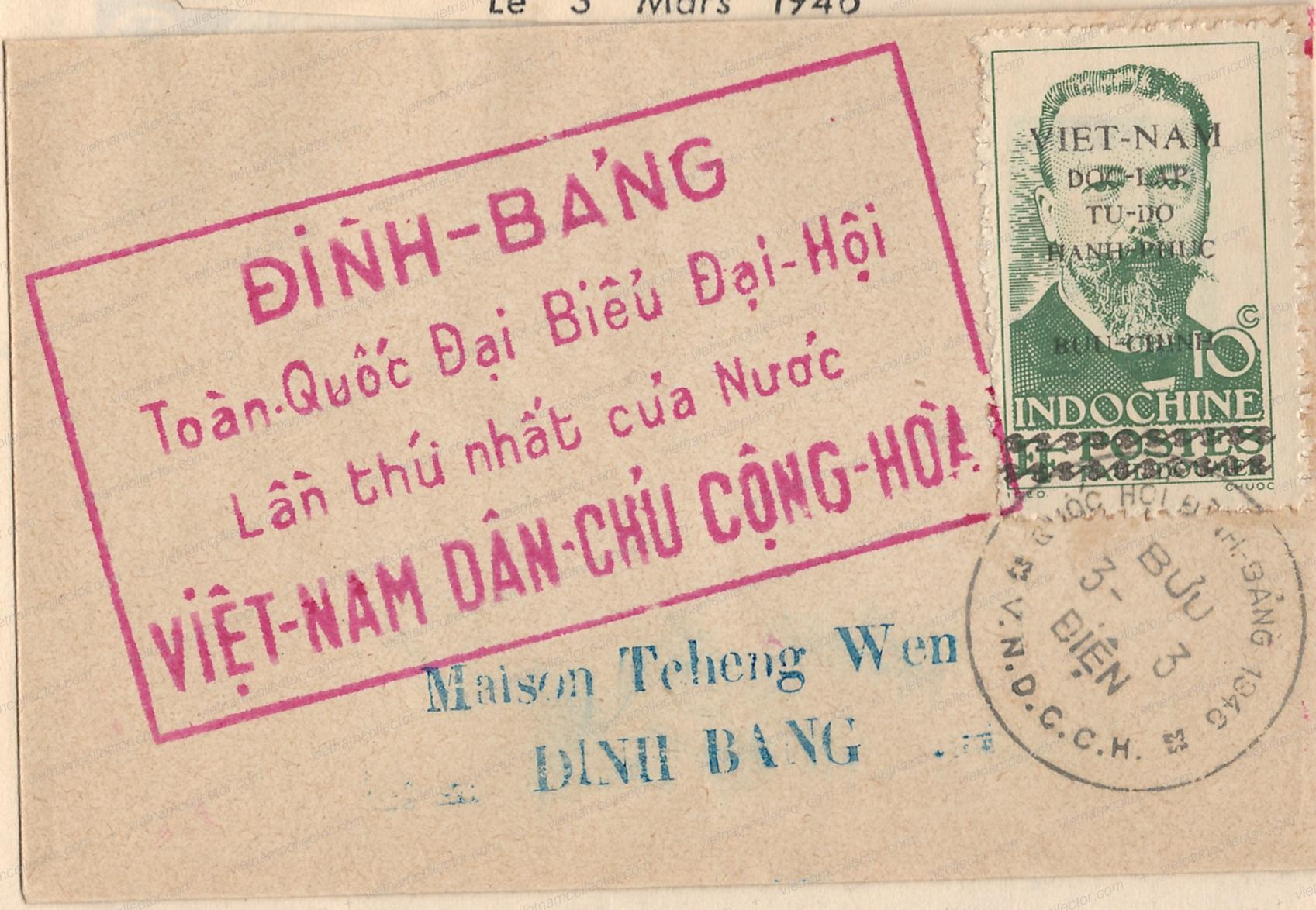
Be careful. The special cancel above is sometimes offered on individual stamps as a fake. The fake cancel differs in many ways from the original and can be easily spotted by comparing the inscription “BUU 3-3 DIEN” . The letters/numbers on the fakes are much different from the originals above.
Here is a single stamp with the forged cancel. Note the different shape of the accent marks and the heavier letters in general.
Favor cancelled un-addressed envelopes as seen below were employed to obtain cancelled versions of these stamps. Some postal clerks insisted on stamps being applied to a cover or piece of paper prior to cancelling them. Beware of covers were an address was added after the fact in order to simulate a postally used cover. Covers that travelled through the mail are always more expensive than purely favor cancelled covers.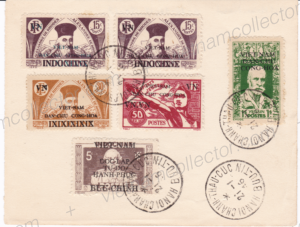
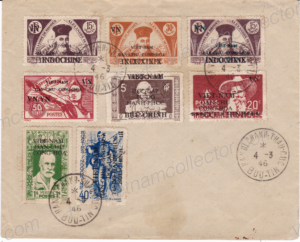
Philatelic letter prepared by “Maison Vietnam Philatelique” using one of the 9 Hao HCM stamps along with some Viet Minh overprints. The letter was cancelled with the Hanoi Trung Uong Bac Bo canceller on November 8th, 1946.
Here are two examples of a cover and post card where it is more difficult to determine if they actually were transported through the post or if they were simply favor cancelled. Both items are hopelessly over-franked above the required tariff. The first is an adversity cover that was fashioned out of an old envelope “Societe Indochinoise Forestiere et des Allumettes” that was simply inverted. There is a cancel on the back but since it is identical to the one that was used to cancel the stamps it probably represents a favor cancelled item. The second is a picture postcard showing a rural village in Than Hoa (Annan). Since it was cancelled in Hanoi the card was also likely a favor cancel.
As in the 1st series of overprints these stamps found very little use. So cancelled specimens are always much rarer than mint ones. This is even true for cancelled to order items as the ones below. Just try to complete the set cancelled. It will take you years to do so.
If you are very lucky you will be able to acquire a booklet that was produced by a private company (Viet-Nam Philatelique in Hanoi) around the time when these stamps were issued. It contains the entire set of Viet Minh overprints plus the first Ho Ch Minh stamps issued in 1946 all in used condition. This item carries a running number 25 suggesting a low number of booklets prepared and a sales price at the time of $200 (200 Piastres).Here shown are only the front and first page of the booklet.
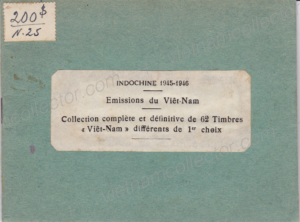
With a little patience one can even find complete sheets of the mint or (rarer) CTO stamps:
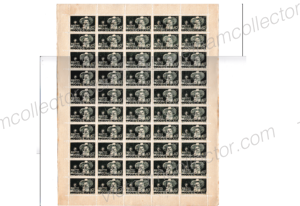 Black overprint. Perforation 12.0
Black overprint. Perforation 12.0
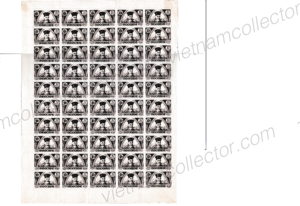
Green Overprint. Perforation 12.0
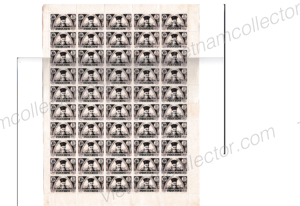
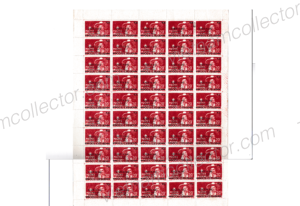
Perforation 12.0
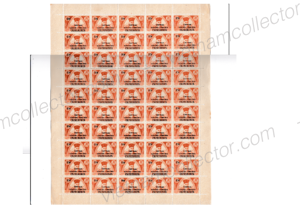 Perforation 14.0
Perforation 14.0
Here is the complete sheet of the 1 Piastre value that features both overprint types of this stamp. In one the “V” of Vietnam is vertically lined up with the “D” of Dan. In the other the “D” of Dan is situated a bit to the right of the “V” of Vietnam. The varieties occur in equal parts on the sheet.
Here is a sample of the 100 Dog banknotes that the Viet Minh issued in 1946, a time when they were basically tolerated by the French colonists and hence were able to conduct better printing operations.
Front
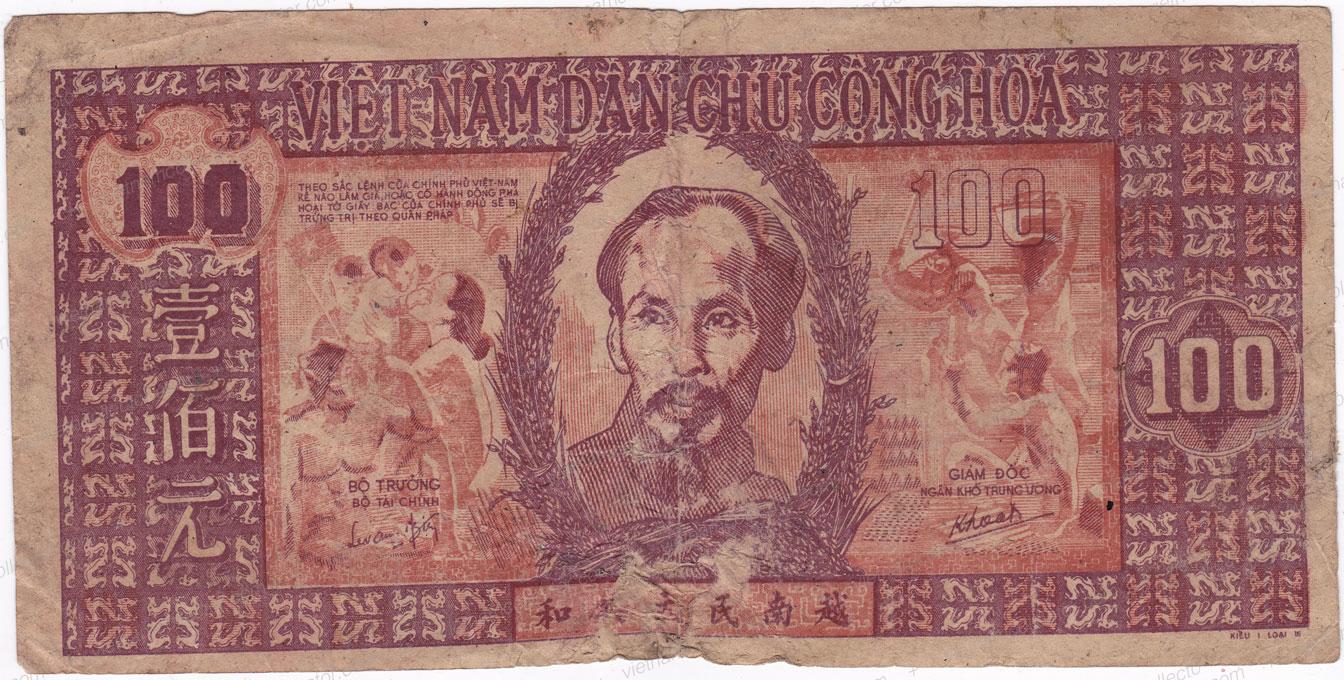
Reverse
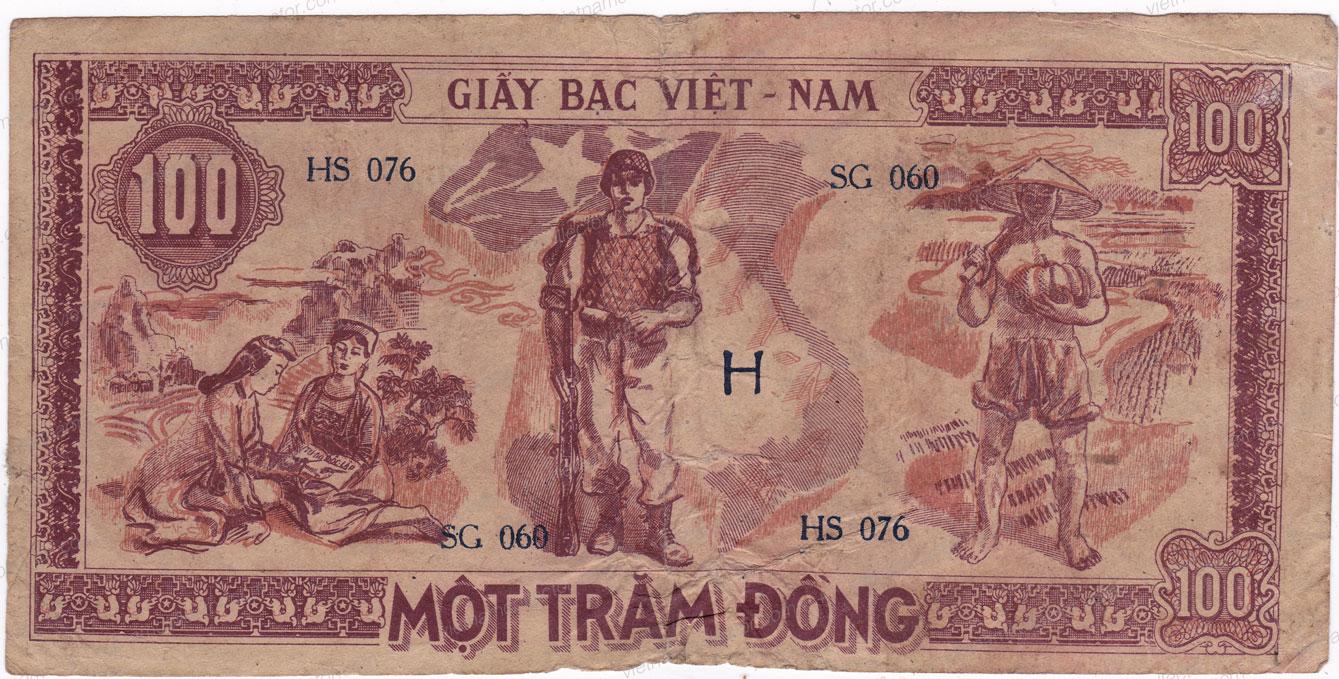

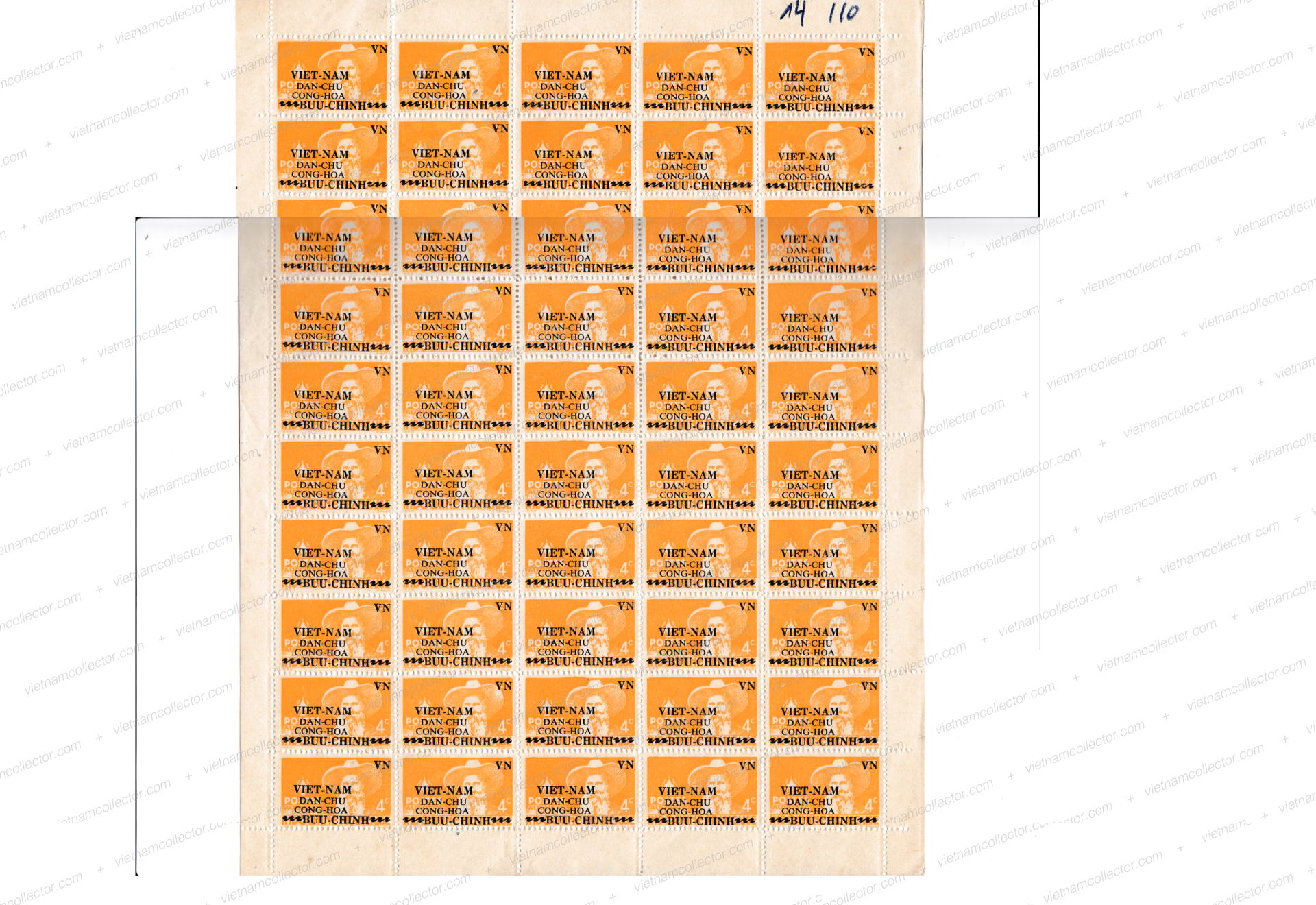
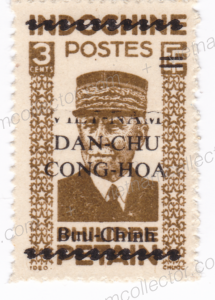
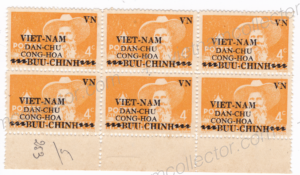
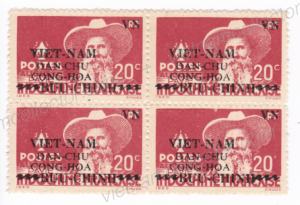

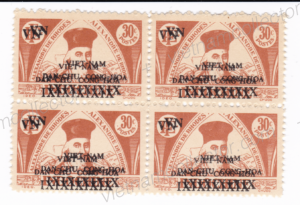
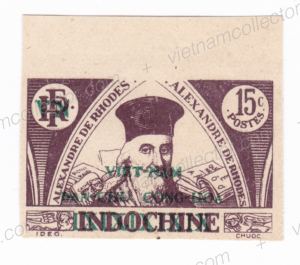
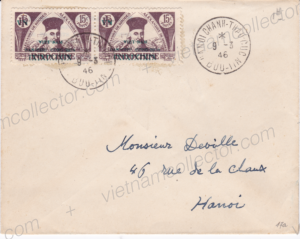
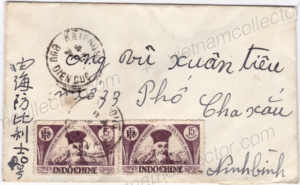
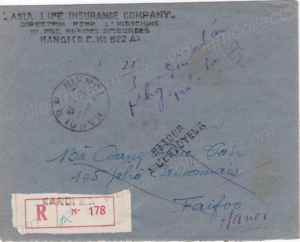
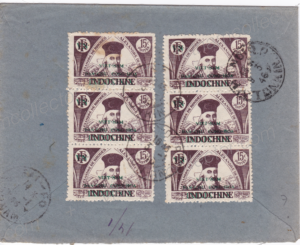
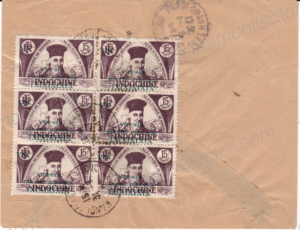
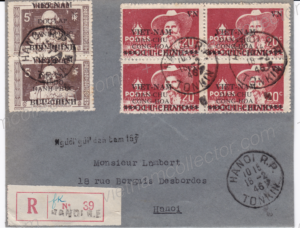
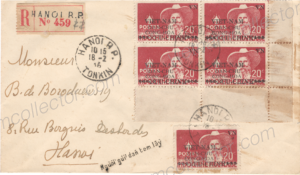
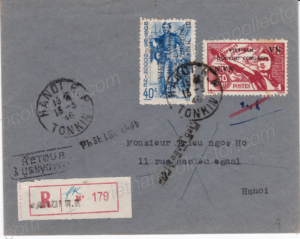
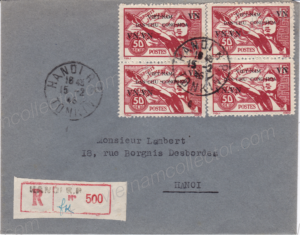
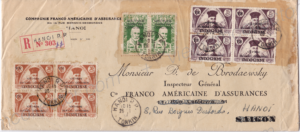
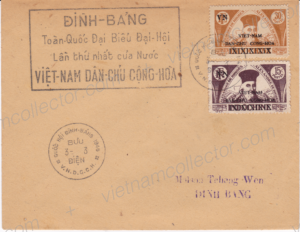
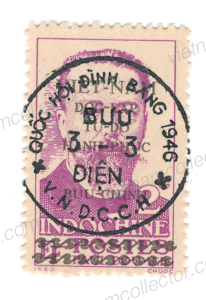
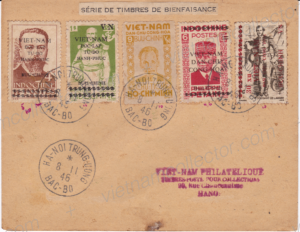
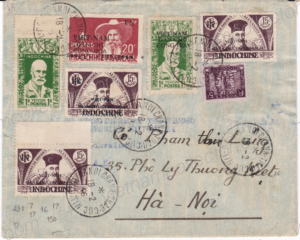
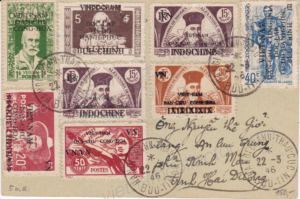
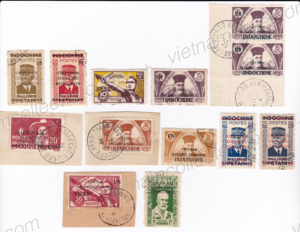
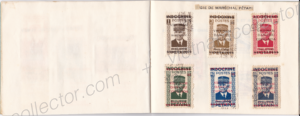
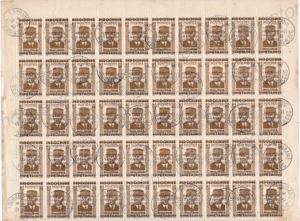
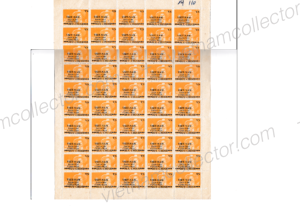
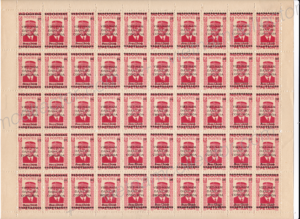
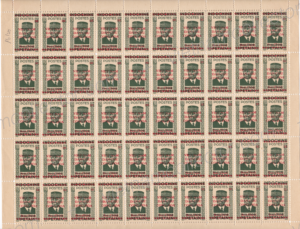
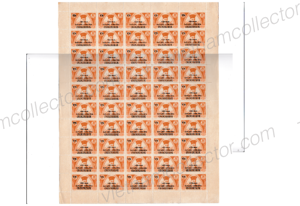
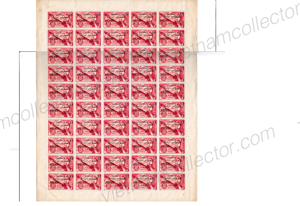
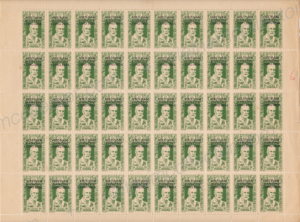
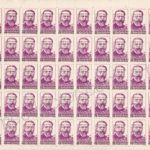
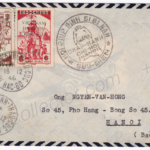


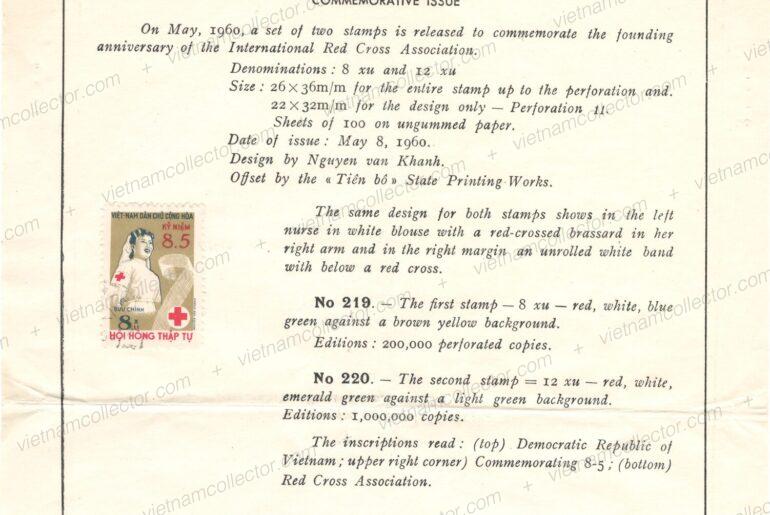
Comments are closed.